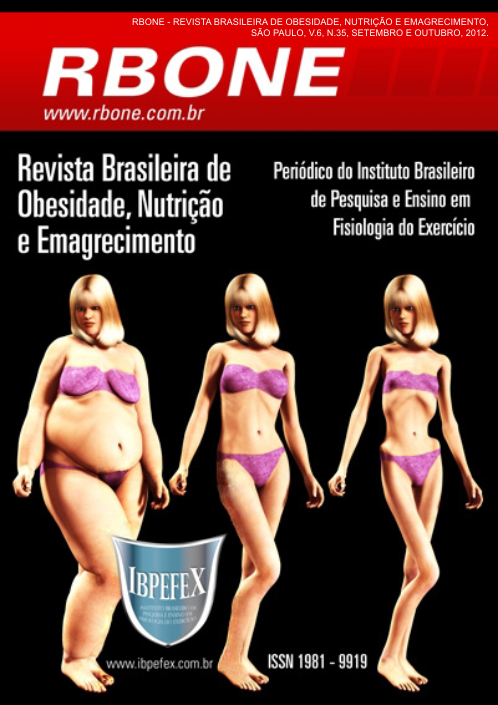The nutrition education group and its effectiveness in obese patients treating
Abstract
Introduction: Obesity is now viewed as an independent risk factor for coronary events, since even after controlling for associated diseases, such as hypertension, dyslipidemia and diabetes mellitus, the risk remains high. Objective: To evaluate the anthropometric and nutritional, noting the reduction in weight and waist circumference and change in dietary pattern of patients treated by the protocol of nutritional group. Materials and Methods: We conducted nutritional counseling group with hypocaloric diet and slimming and meetings addressing healthy lifestyles, with 40 obese patients (BMI ≥ 30 kg / m²), of both sexes, biweekly for 6 months. We evaluated the changes in weight, waist circumference and dietary habits that. Results: After the monitoring period, we observed an average weight reduction of 5.9% and waist circumference by 5.2% (p = 0.000). An improvement in eating patterns, both with respect to the total caloric value, which showed an average reduction of 27% (p = 0.000), from baseline to the end of the program, with respect to consumption of macro and micronutrients, which was a reduction of 55.66% in the consumption of sodium (p = 0.000) and 46.45% increase in fiber intake (p = 0.000). Conclusion: The program proved to be very effective for reducing weight and eating habits. Shares of Nutrition Education Group should be encouraged and enhanced, helping to combat obesity and its comorbidities.
References
-Agência Nacional de Vigilância Sanitária -ANVISA. Manual de orientação aos consumidores Educação para o Consumo Saudável. 2008.
-Buttriss, J.L. Food and nutrition: attitudes, beliefs, and knowledge in the United Kingdom. Am J Clin Nutr. Vol. 65. 1997. p. 1985S-1995S.
-Davies, K.M.; Heaney, R.P.; Recker, R.R.; Lappe, J.M.; Barger-Lux, M.J. Calcium intake and body weight. J Clin Endocrinol Metab. Vol. 85. 2000. p. 4635-4638.
-Gordon, C.C.; Chumlea, W.C.; Roche, A.F. Stature, recumbent length, and weight. In. Lohman, T.G. Anthropometric standardization reference manual. Champaign. Human Kinetics Books.1991. p. 3-8.
-Hans, T.S.; Van Leer, E.M.; Seidell, J.C.; Lean, M.E. Waist circumference action levels in the identification of cardiovascular risk factors: prevalence study in a random sample. BMJ. Vol. 311. Num. 7017. 1995. p. 1401-1405.
-He, J.; Ogden, L.G.; Vupputuri, S.; Bazzano, L.A.; Loria, C.; Whelton, P.K. Dietary sodium intakeand subsequent risk of cardiovascular disease in overweight adults. Journal of the American Medical Association. Vol. 282. Num. 21. 1999. p. 2027–2034.
-Instituto Brasileiro de Geografia e Estatística. Pesquisa de orçamento familiar -POF 2008-2009. Avaliação Nutricional da Disponibilidade Domiciliar de Alimentos no Brasil. Rio de Janeiro. 2010.
-Kessler, R.; Greenberg, P.; Mickelson, K.; e colaboradores. The Effects of Chronic Medical Conditions on Work Loss and Work Cutback. J Occup Environ Med. Vol. 43. Num. 3. 2001. p. 218-25.
-Kovacs, C.; Moreira, P.; Romualdo, M.; Amparo, F.C.; Magnoni, D. Aplicação de uma ferramenta de educação nutricional em grupo para pacientes com excesso de peso e sua efetividade na mudança de parâmetros antropométricos. Rev Sociedade de Cardiologia do Estado de São Paulo. Vol. 20. 2010. p. 9-13.
-Lattimer, J.M.; Haub, M.D. Effects of Dietary Fiber and Its Components on Metabolic Health. Nutrients. Vol. 2. Num. 12. 2010. p. 1266-1289.
-OPAS. Guia Clinico para Atencion Primaria a lãs Personas Adultas Mayores. 2002.
-Pereira, L.O.; Francischi, R.P.; Lancha Júnior, A.H. Obesidade: causas e consequências. Arq Bras Endocrinol Metab. Vol. 47. 2003. p. 111-27.
-Philippi, S.T. (Org.), Silva, G.V.; Pimentel, C.V.M.B. Pirâmide dos alimentos: fundamentos básicos da nutrição. Barueri. Manole. 2008.
-Poirier, P.; Thomas, D.; Bray, G.; Hong, Y.; Stern, J.; Pi-Sunyer, X.; Eckel, R.H. Obesity and cardiovascular disease: pathophysiology, evaluation, and effect of weight loss. Arterioscler Thromb Vasc Biol. Vol. 26. 2006. p. 968-976.
-Sociedade Brasileira de Cardiologia / Sociedade Brasileira de Hipertensão / Sociedade Brasileira de Endocrinologia e Metabologia / Sociedade Brasileira de Diabetes / Associação Brasileira para o Estudo sobre a Obesidade. I Diretriz Brasileira de Diagnóstico e Tratamento da Síndrome Metabólica. Rev Soc Bras Hipertensão. Vol. 7. Num. 4. 2004. p. 123-159.
-Sociedade Brasileira de Cardiologia / Sociedade Brasileira de Hipertensão / Sociedade Brasileira de Nefrologia. VI Diretrizes Brasileiras de Hipertensão. Arq Bras Cardiol Vol. 95. Num. 1. Supl. 1. 2010. p. 1-51.
-Sociedade Brasileira de Cardiologia. I Diretriz Brasileira de Diagnóstico e Tratamento da Síndrome Metabólica. Arq Bras Cardiol. Vol. 84 Supl. 1. 2005. p. 1-28.
-Sociedade Brasileira de Cardiologia. IV Diretriz brasileira sobre dislipidemias e prevenção da aterosclerose. Departamento de Aterosclerose da Sociedade Brasileira de Cardiologia. Arq Bras Cardiol. Vol. 88. Supl. 1. 2007a. p.1-18.
-Sociedade Brasileira de Cardiologia. V Diretrizes Brasileiras de Hipertensão Arterial. Arq Bras Cardiol. Vol. 89. Num. 3. 2007b. p. e24-e79.
-Wanderley, E.M.; Ferreira, V.A. Obesidade: uma perspectiva plural. Ciência & Saúde Coletiva. Vol. 15. Num. 1. 2010. p.185-194.
-Willett, W.C.; Dietz, W.H.; Colditz, G.A. Guidelines for health weight. N Eng J Med. Vol. 341. Num. 6. 1999. p. 427-434.
-World Health Organization. Obesity: preventing and managing the global epidemic. Geneva, 1997. Report of a WHO Consultation on Obesity.
-World Health Organization. Obesity: preventing and managing the global epidemic. Geneva, 1998. Report of a WHO Consultation on Obesity.
Authors who publish in this journal agree to the following terms:
- Authors retain the copyright and grant the journal the right of first publication, with work simultaneously licensed under the Creative Commons Attribution License BY-NC which allows the sharing of the work with acknowledgment of the authorship of the work and initial publication in this journal.
- Authors are authorized to enter into additional contracts separately for non-exclusive distribution of the version of the work published in this journal (eg, publishing in institutional repository or book chapter), with acknowledgment of authorship and initial publication in this journal.
- Authors are allowed and encouraged to post and distribute their work online (eg, in institutional repositories or on their personal page) at any point before or during the editorial process, as this can bring about productive change as well as increase impact and impact. citation of published work (See The Effect of Free Access).






